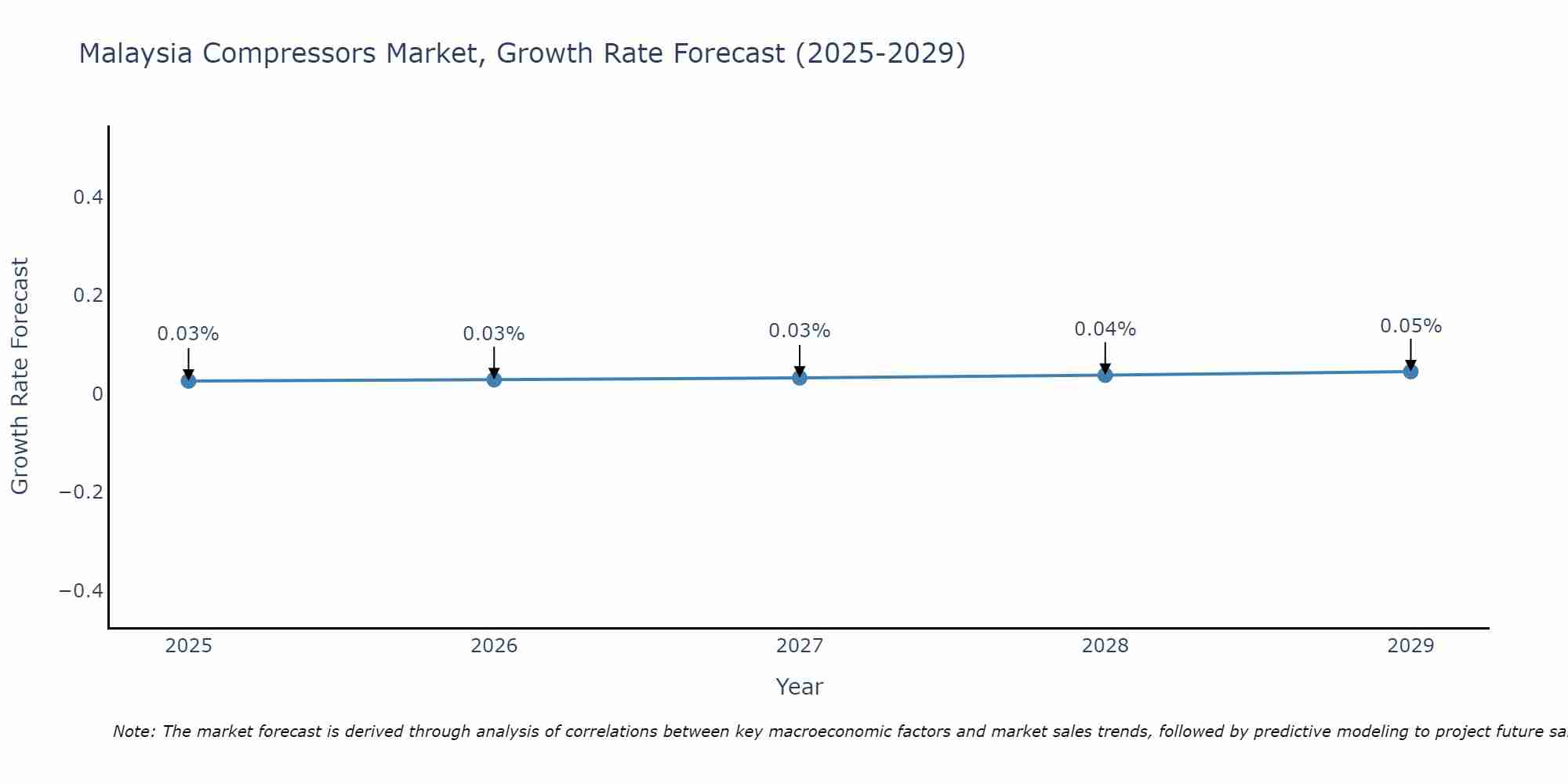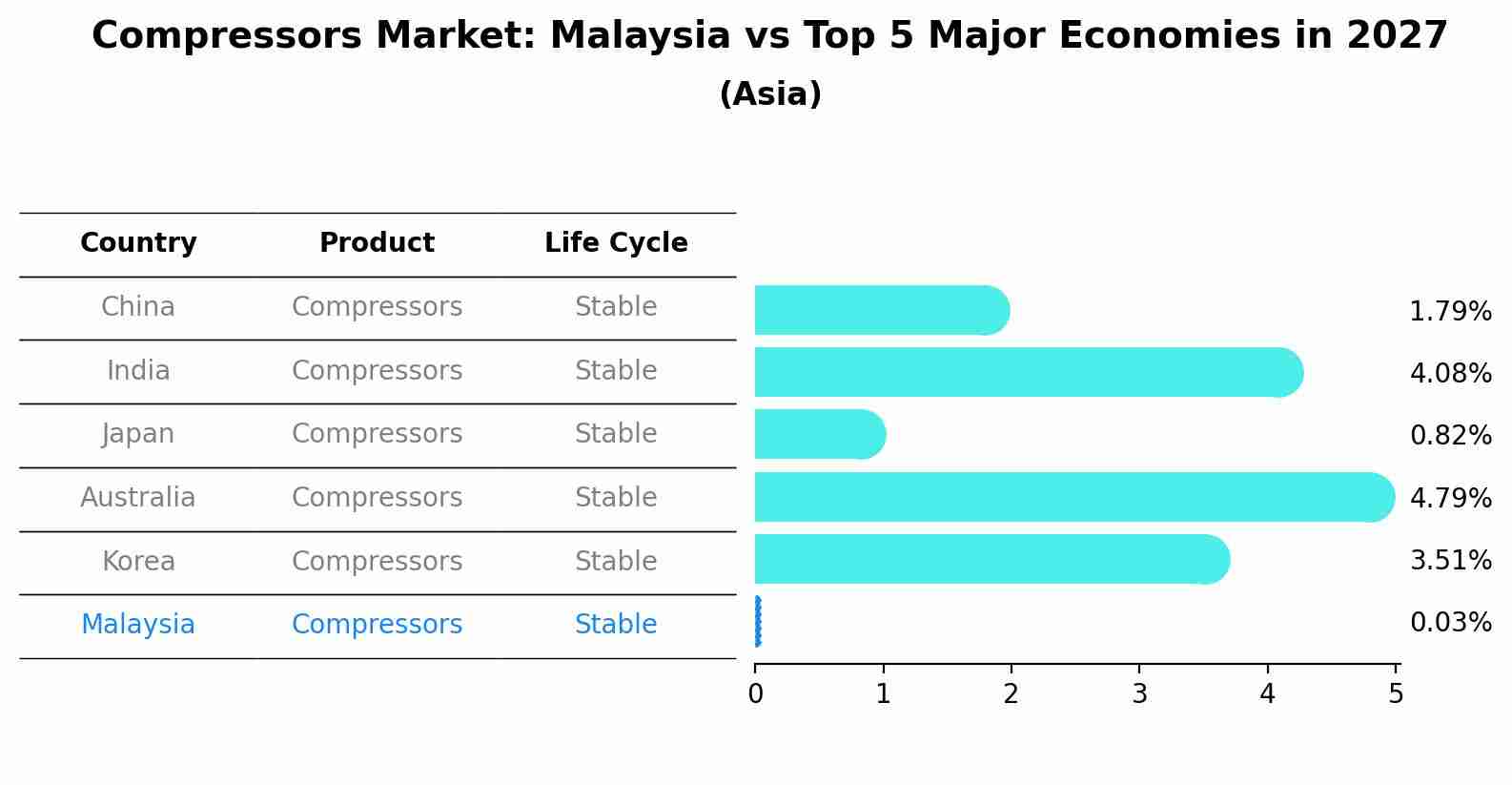Malaysia Compressors Market (2024-2030) | Growth, Industry, Share, Size, Trends, Value, Forecast, Outlook, Analysis, Companies & Revenue
| Product Code: ETC023746 | Publication Date: Jun 2023 | Updated Date: Apr 2025 | Product Type: Report | |
| Publisher: 6Wresearch | Author: Ravi Bhandari | No. of Pages: 70 | No. of Figures: 35 | No. of Tables: 5 |
Malaysia Compressors Market Size Growth Rate
The Malaysia Compressors Market is poised for steady growth rate improvements from 2025 to 2029. From 0.03% in 2025, the growth rate steadily ascends to 0.05% in 2029.

Compressors Market: Malaysia vs Top 5 Major Economies in 2027 (Asia)
By 2027, Malaysia's Compressors market is forecasted to achieve a stable growth rate of 0.03%, with China leading the Asia region, followed by India, Japan, Australia and South Korea.

Malaysia Compressors Market Synopsis
The Malaysia compressors market is expected to grow at a CAGR of 6.8% during the forecast period 2020-2026. This growth can be attributed to the rising demand for air conditioning equipment in various sectors, such as industrial, commercial and residential, across Malaysia. In addition, growing investment in manufacturing is also driving the demand for compressors in Malaysia. The increasing government initiatives towards energy efficiency and sustainability are further boosting the adoption of compressor solutions among users in the region. Furthermore, technological advancements such as silent design compressors with high performance capabilities are leading to an increased usage of these products among customers from various industries like construction and automotive
Key Challenges Faced by The Market
However, fluctuating prices of raw materials used for manufacturing compressors may hamper the growth of this market over the forecast period .In addition , rising competition from local manufacturers may also impede overall market growth over time
Key Highlights of the Report:
- Malaysia Compressors Market Outlook
- Market Size of Malaysia Compressors Market, 2023
- Forecast of Malaysia Compressors Market, 2030
- Historical Data and Forecast of Malaysia Compressors Revenues & Volume for the Period 2020-2030
- Malaysia Compressors Market Trend Evolution
- Malaysia Compressors Market Drivers and Challenges
- Malaysia Compressors Price Trends
- Malaysia Compressors Porter's Five Forces
- Malaysia Compressors Industry Life Cycle
- Historical Data and Forecast of Malaysia Compressors Market Revenues & Volume By Type for the Period 2020-2030
- Historical Data and Forecast of Malaysia Compressors Market Revenues & Volume By Positive Displacement for the Period 2020-2030
- Historical Data and Forecast of Malaysia Compressors Market Revenues & Volume By Dynamic for the Period 2020-2030
- Historical Data and Forecast of Malaysia Compressors Market Revenues & Volume By Industry for the Period 2020-2030
- Historical Data and Forecast of Malaysia Compressors Market Revenues & Volume By Automotive for the Period 2020-2030
- Historical Data and Forecast of Malaysia Compressors Market Revenues & Volume By Steel for the Period 2020-2030
- Historical Data and Forecast of Malaysia Compressors Market Revenues & Volume By Chemical for the Period 2020-2030
- Historical Data and Forecast of Malaysia Compressors Market Revenues & Volume By Medical for the Period 2020-2030
- Historical Data and Forecast of Malaysia Compressors Market Revenues & Volume By Others for the Period 2020-2030
- Malaysia Compressors Import Export Trade Statistics
- Market Opportunity Assessment By Type
- Market Opportunity Assessment By Industry
- Malaysia Compressors Top Companies Market Share
- Malaysia Compressors Competitive Benchmarking By Technical and Operational Parameters
- Malaysia Compressors Company Profiles
- Malaysia Compressors Key Strategic Recommendations
Frequently Asked Questions About the Market Study (FAQs):
1 Executive Summary |
2 Introduction |
2.1 Key Highlights of the Report |
2.2 Report Description |
2.3 Market Scope & Segmentation |
2.4 Research Methodology |
2.5 Assumptions |
3 Malaysia Compressors Market Overview |
3.1 Malaysia Country Macro Economic Indicators |
3.2 Malaysia Compressors Market Revenues & Volume, 2020 & 2030F |
3.3 Malaysia Compressors Market - Industry Life Cycle |
3.4 Malaysia Compressors Market - Porter's Five Forces |
3.5 Malaysia Compressors Market Revenues & Volume Share, By Type, 2020 & 2030F |
3.6 Malaysia Compressors Market Revenues & Volume Share, By Industry, 2020 & 2030F |
4 Malaysia Compressors Market Dynamics |
4.1 Impact Analysis |
4.2 Market Drivers |
4.3 Market Restraints |
5 Malaysia Compressors Market Trends |
6 Malaysia Compressors Market, By Types |
6.1 Malaysia Compressors Market, By Type |
6.1.1 Overview and Analysis |
6.1.2 Malaysia Compressors Market Revenues & Volume, By Type, 2020-2030F |
6.1.3 Malaysia Compressors Market Revenues & Volume, By Positive Displacement, 2020-2030F |
6.1.4 Malaysia Compressors Market Revenues & Volume, By Dynamic, 2020-2030F |
6.2 Malaysia Compressors Market, By Industry |
6.2.1 Overview and Analysis |
6.2.2 Malaysia Compressors Market Revenues & Volume, By Automotive, 2020-2030F |
6.2.3 Malaysia Compressors Market Revenues & Volume, By Steel, 2020-2030F |
6.2.4 Malaysia Compressors Market Revenues & Volume, By Chemical, 2020-2030F |
6.2.5 Malaysia Compressors Market Revenues & Volume, By Medical, 2020-2030F |
6.2.6 Malaysia Compressors Market Revenues & Volume, By Others, 2020-2030F |
7 Malaysia Compressors Market Import-Export Trade Statistics |
7.1 Malaysia Compressors Market Export to Major Countries |
7.2 Malaysia Compressors Market Imports from Major Countries |
8 Malaysia Compressors Market Key Performance Indicators |
9 Malaysia Compressors Market - Opportunity Assessment |
9.1 Malaysia Compressors Market Opportunity Assessment, By Type, 2020 & 2030F |
9.2 Malaysia Compressors Market Opportunity Assessment, By Industry, 2020 & 2030F |
10 Malaysia Compressors Market - Competitive Landscape |
10.1 Malaysia Compressors Market Revenue Share, By Companies, 2023 |
10.2 Malaysia Compressors Market Competitive Benchmarking, By Operating and Technical Parameters |
11 Company Profiles |
12 Recommendations |
13 Disclaimer |
- Single User License$ 1,995
- Department License$ 2,400
- Site License$ 3,120
- Global License$ 3,795
Search
Thought Leadership and Analyst Meet
Our Clients
Related Reports
- Germany Breakfast Food Market (2026-2032) | Industry, Share, Growth, Size, Companies, Value, Analysis, Revenue, Trends, Forecast & Outlook
- Australia Briquette Market (2025-2031) | Growth, Size, Revenue, Forecast, Analysis, Trends, Value, Share, Industry & Companies
- Vietnam System Integrator Market (2025-2031) | Size, Companies, Analysis, Industry, Value, Forecast, Growth, Trends, Revenue & Share
- ASEAN and Thailand Brain Health Supplements Market (2025-2031) | Strategy, Consumer Insights, Analysis, Investment Trends, Opportunities, Growth, Size, Share, Industry, Revenue, Segments, Value, Segmentation, Supply, Forecast, Restraints, Outlook, Competition, Drivers, Trends, Demand, Pricing Analysis, Competitive, Strategic Insights, Companies, Challenges
- ASEAN Bearings Market (2025-2031) | Strategy, Consumer Insights, Analysis, Investment Trends, Opportunities, Growth, Size, Share, Industry, Revenue, Segments, Value, Segmentation, Supply, Forecast, Restraints, Outlook, Competition, Drivers, Trends, Demand, Pricing Analysis, Competitive, Strategic Insights, Companies, Challenges
- Europe Flooring Market (2025-2031) | Outlook, Share, Industry, Trends, Forecast, Companies, Revenue, Size, Analysis, Growth & Value
- Saudi Arabia Manlift Market (2025-2031) | Outlook, Size, Growth, Trends, Companies, Industry, Revenue, Value, Share, Forecast & Analysis
- Uganda Excavator, Crane, and Wheel Loaders Market (2025-2031) | Strategy, Consumer Insights, Analysis, Investment Trends, Opportunities, Growth, Size, Share, Industry, Revenue, Segments, Value, Segmentation, Supply, Forecast, Restraints, Outlook, Competition, Drivers, Trends, Demand, Pricing Analysis, Competitive, Strategic Insights, Companies, Challenges
- Rwanda Excavator, Crane, and Wheel Loaders Market (2025-2031) | Strategy, Consumer Insights, Analysis, Investment Trends, Opportunities, Growth, Size, Share, Industry, Revenue, Segments, Value, Segmentation, Supply, Forecast, Restraints, Outlook, Competition, Drivers, Trends, Demand, Pricing Analysis, Competitive, Strategic Insights, Companies, Challenges
- Kenya Excavator, Crane, and Wheel Loaders Market (2025-2031) | Strategy, Consumer Insights, Analysis, Investment Trends, Opportunities, Growth, Size, Share, Industry, Revenue, Segments, Value, Segmentation, Supply, Forecast, Restraints, Outlook, Competition, Drivers, Trends, Demand, Pricing Analysis, Competitive, Strategic Insights, Companies, Challenges
Industry Events and Analyst Meet
Whitepaper
- Middle East & Africa Commercial Security Market Click here to view more.
- Middle East & Africa Fire Safety Systems & Equipment Market Click here to view more.
- GCC Drone Market Click here to view more.
- Middle East Lighting Fixture Market Click here to view more.
- GCC Physical & Perimeter Security Market Click here to view more.
6WResearch In News
- Doha a strategic location for EV manufacturing hub: IPA Qatar
- Demand for luxury TVs surging in the GCC, says Samsung
- Empowering Growth: The Thriving Journey of Bangladesh’s Cable Industry
- Demand for luxury TVs surging in the GCC, says Samsung
- Video call with a traditional healer? Once unthinkable, it’s now common in South Africa
- Intelligent Buildings To Smooth GCC’s Path To Net Zero


















